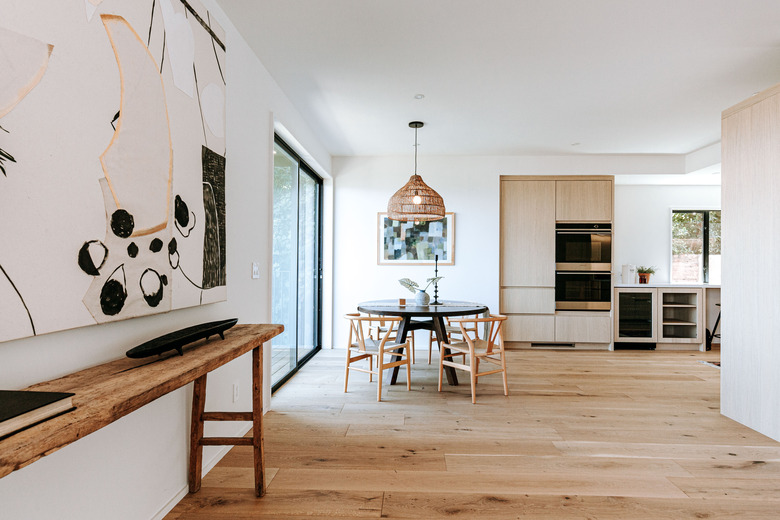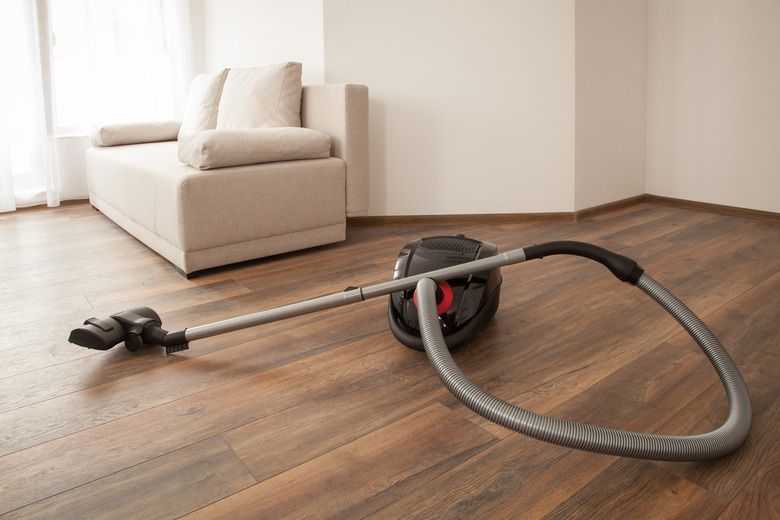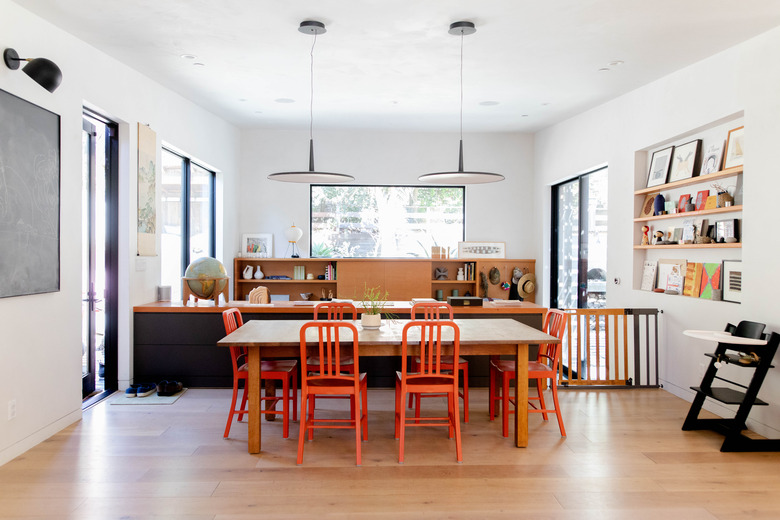How To Clean Hardwood Floors
We may receive a commission on purchases made from links.
When it comes to cleaning hardwood floors, there are different techniques needed for different finishes. When spills happen, all you need to do is wipe them up, but some accidents can leave permanent damage if you don't address them right away. Don't panic — for every stain, there is a solution. By following a few cleaning tips and keeping a consistent maintenance schedule, your floors will always look as good as new.
Practice Prevention on Wood Floors
Practice Prevention on Wood Floors
According to the National Wood Flooring Association, wood floors can last decades with proper care and maintenance. To keep them free from scratches, dents and cracks, use protector pads under furniture, avoid walking on them in high heels or cleats and trim your pets' nails regularly. Do not let spills sit for long — wipe them up as soon as you see them.
Over time, wood floors can dull. Make sure to sweep or vacuum hardwood consistently to keep it free of dust, dirt and other particles that can scratch the floor's protective finish. Using the wrong cleaning products or vacuum attachments may also do more harm than good. To make your floors shine again, use only products recommended by a contractor or the flooring or finish manufacturer. How you clean your floor will depend on how it's finished, not what kind of wood it is. A wood floor can have one of two finishes:
- A surface-finished floor is generally waterproof, as it has a urethane or polyurethane barrier coating it. When a spill occurs, the liquid pools on top of the wood, but won't seep into it. When cleaning a floor with a surface finish, it safe to use products that are water-based.
- Natural oils such as linseed or tung topped with wax coating create a penetrating finish. Clean using solvent-based products only, as this type of finish easily absorbs water.
Use a small knife on a hidden area of the floor to scrape off a little finish. If you bring up clear coating, the floor likely has a surface finish. If no material comes up and the floor smudges, it probably has a penetrating finish.
Maintain a Schedule to Clean Hardwood Floors
Maintain a Schedule to Clean Hardwood Floors
If you follow a schedule by which to clean your floors, they should keep their luster for many years to come.
- Sweep, dust or mop daily.
- Mop heavily trafficked areas twice a week.
- Every month, clean with the recommended cleaner for your specific finish.
- Apply a new coat of finish every three to five years.
- Sand and refinish your floor only as needed, such as when the floor boards and/or finish are damaged and a recoat is not possible. Not all hardwood floors are suitable for sanding and refinishing.
Keeping Hardwood Floors Dust-Free
Keeping Hardwood Floors Dust-Free
Mop, sweep or dust floors to keep them free of debris using the following tools:
- A dry mop with a large, fixed, flat head that holds a microfiber cloth pad.
- A broom with exploded tips that collects dust in the broom head.
- A vacuum cleaner with a floor-brush attachment. Do not use a vacuum beater bar on hardwood, as the rotating brush may dent it.
Move these cleaning tools over one side of the floor to the other to collect debris, paying particular attention to where adjacent floorboards meet as you go.
Deep-Cleaning a Dirty Floor
Deep-Cleaning a Dirty Floor
To rid your floor of caked-up grime and dirt, you may want to deep-clean it.
For floors with a surface finish:
- Use a pH-neutral, wax-free and petroleum-free floor cleaner. You can also make your own homemade cleaning solution with few drops of dish soap and a gallon of warm water.
- Wet a sponge mop with floor cleaner and wring out the excess liquid so the sponge is only slightly damp. Mop one 3-foot section of the floor using a circular motion to pull up excess dirt and then move on to the next section.
- Rinse the mop using water, wring it out and continue mopping the floor to soak up the remainder of the cleaning solution. As when washing, wring out the mop thoroughly to prevent over-wetting the floor.
- Dry with a soft, clean towel.
For floors with a penetrating finish:
- Strip off the old wax coating.
- Wipe down the floor in 2-foot sections using a clean cloth saturated in mineral spirits.
- Let the cleaning solution sit for five minutes on each section before wiping it off with a fresh, slightly damp cloth.
- Using a fresh, dry cloth, wipe away any excess moisture.
- Reapply solvent-based floor wax. Use a cloth or an electric polisher to buff the wax into the floor.
Removing Hard Food Stains
Removing Hard Food Stains
- To remove caked-on food from a floor with a surface or penetrating finish, push the tip of a plastic knife under the lower edge of the debris and slide the knife upward gently.
- If your floor has a surface finish, rub the area with a clean, slightly damp cloth and follow it with a dry cloth to remove any excess moisture.
- If the floor has a penetrating finish and a bit of wax coating comes up in the process, reapply solvent-based floor wax using a soft cloth and buff it in.
Cleaning Oil and Grease Stains
Cleaning Oil and Grease Stains
Hardwood floors are absorbent so they're likely to absorb oil and grease spilled on them, leaving a messy stain. Absorbent powders are the best approach to tackling these stains. If that doesn't work, sanding out the oil marks or applying a darker wood stain over your floors to camouflage the marks may be the only options.
- Sprinkle a thick layer (about 1/4 inch) of baking soda over the stained area.
- Leave the powder on overnight or throughout the day.
- Remove the powder by vacuuming it up.
- Mix some dishwashing liquid into a bucket of water and scrub the stained area with a soft brush and this water-detergent mixture.
- Dry the area with a dry cloth.
Removing Wax, Gum, and Crayon Marks
Removing Wax, Gum, and Crayon Marks
Ice works wonders on hard-to-remove debris like dried wax, crayon marks and gum for both surface and penetrating finishes.
- After filling a freezer bag with ice, place it over the debris.
- When it becomes brittle, scrape it off with a plastic spatula.
- If the floor has a penetrating finish and a bit of wax coating comes up in the process, reapply solvent-based floor wax using a soft cloth and buff it in.
Removing Pet Urine, Ink, and Water Spots
Removing Pet Urine, Ink, and Water Spots
Pet urine, ink and water leave some of the most challenging stains and involve a little extra legwork, but it is not impossible to remove them. The steps below apply to penetrating finishes only. Do not use sandpaper or steel wool on floors with a surface finish. Instead, use a hardwood floor cleaner and a scouring pad made specifically for this type of floor.
- Start by lightly sanding the wood with fine sandpaper (120-grit or finer).
- Gently scrub the area with 00-grade steel wool dampened with mineral spirits.
- Wipe away the spirits using a new, water-dampened cloth.
- Use a clean, dry cloth to remove any excess moisture.
- Apply solvent-based floor wax (or other type of finish that matches the original) to the area with a soft cloth and buff it in.


